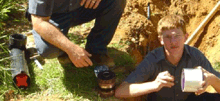A septic system is designed to clean household wastewater and restore it to the ground. This occurs through a two-step operation that involves bacterial digestion to break down solid material and soil filtration to remove toxins. Oxygen is vital to this process. Without air, the system cannot work properly and wastewater will back up, possibly contaminating wells and other water sources. The leach-field, the component that handles this function, is a common culprit in septic systems that perform poorly.
Over time, soil in the field can become densely compacted and deprived of oxygen. The aerobic bacteria responsible for waste digestion die off and the water is unable to percolate through the ground. Pathogenic bacteria and viruses are not filtered out and nitrogen accumulates in the soil. Homeowners may notice slow draining toilets and sinks, frequent blockages in plumbing fixtures, bare patches of ground around the system, and sewage odors inside the home. During servicing, a technician may note that water flows backwards into the holding tank.
Repair traditionally requires digging up the old system and relocating it or installing a new system. Although costly and time consuming, it may still be the best option in many cases. If the old septic system is damaged beyond repair or there is a significant increase in the demand for wastewater processing, a new tank and field line are necessary. Occasionally the old system can be left in place and used as a backup for heavy workloads.
For septic problems caused by poor soil drainage and aeration, lakenormanseptic.com recommends the Terra-lift technology as an affordable alternative. Using special equipment, high-pressure blasts of air are injected deep into the ground at various locations. Creating large fractures in compacted soil, new drainage channels are opened thereby increasing oxygen levels and loosening the dirt. Inserting plastic beads into the ground ensures that the new fissures remain open and prevent soil re-compaction. Ultimately, this leads to better waste water filtration and lower nitrogen levels in the system.




